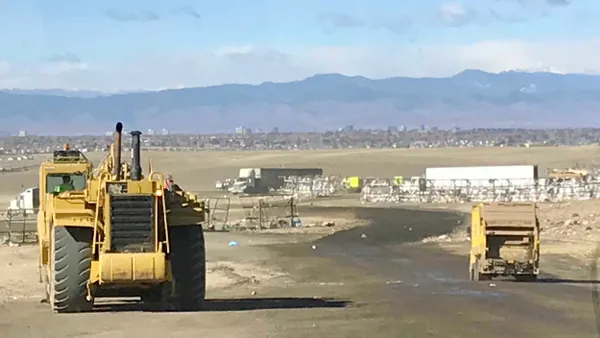Dive Brief:
- Heightened temperatures have been detected at landfills around the country, and while the causes are unconfirmed, researchers believe they may often be tied to reactive industrial wastes. According to Navid Jafari at the department of Civil and Environmental Engineering at Louisiana State University, aluminum, ash, lime kiln dust, and other wastes could cause the noted heat reaction, and these reactions may be specific to both waste type and region.
- Jafari cites the Countywide Landfill in Stark County, Ohio as a trigger, which alerted the waste industry about the issue several years ago. "Temperatures significantly increased to greater than 200 degrees Fahrenheit when the facility recirculated leachate in areas where aluminum production wastes were disposed in the MSW landfill," he said to Waste360.
- Henry Kerfoot, principal for Civil & Environmental Consultants Inc. (CEC) in Phoenix, AZ, claims the reactions are neither from combustion nor fire, explaining that the temperatures are not high enough to involve combustion. He said there are likely combined reactions tied to the heat-generation, which is identified through raised landfill gas temperatures. Researchers are looking for mechanisms and prevention methods.
Dive Insight:
Landfill engineering and operations, including in relation to elevated landfill temperatures, have been ongoing focuses in the solid waste management industry. Among concerns is the potential for fires, which can smolder for years and pose serious risks.
Researchers are especially honing in on possible causes for these landfill temperatures and patterns. One believed common denominator, in addition to a lack of combustion, is that the waste is saturated with water. As the investigation continues, researchers are not only looking for patterns in waste source and geographical location, but are focusing on mechanisms in search for solutions.
"The common mechanism causing elevated temperatures is the introduction of ambient air into a landfill during gas collection and control operations and/or poor cover maintenance," said Jafari to Waste360. "When landfill operators increase the vacuum to enhance methane recovery for energy production, oxygen can enter the landfill … Aerobic decomposition can start from these and other actions that allow oxygen to enter the waste … waste temperatures in aerobic conditions can increase to 175 degrees Fahrenheit and higher if smoldering combustion develops."
Some researchers say focusing on operation of gas collection systems and whether leachate is recirculating is critical.








